Sakura Lounge – One of their best works
Japanese English
[Profile]
The de Keyzer Brothers (a.k.a. The de Keyzers)

Elder Brother: Shaun de Keyzer (left)
Younger Brother: Neil de Keyzer (right)
The brothers were born in Melbourne and raised in Kyoto. After gaining experience as daiku in Japan, they moved back to their birthplace, Melbourne. The de Keyzer brothers started their professional career as daiku and have been working in many different areas including interior architecture. Some of the masterpieces include: Sakura Lounge, Chanoyu Natural Beauty and Spa, Wabi Sabi, and Maedaya and EN Izakaya.
— What made you a *daiku?
Shaun: Our house in Kameoka, Kyoto was only half done when we moved in. We finished the rest under the lead of our father. That’s when I first developed my interest in carpentry.
* Daiku is the English equivalent of carpenter. It is a respectable profession that requires formal training with strict standards in Japan.
— How is the feedback from clients regarding your works?
Shaun: Certainly, we have been receiving positive feedback from clients, and we got wonderful comments from those who looked at our works, too.
— What are some of the popular requests you get here in Australia? Would that be to incorporate traditional Japanese essence as expected?
Neil: So far we don’t really get specific requests from clients here. Of course we are told the big direction like “I want a door here”, but since we are given much freedom in designing and production, we actually give advice and suggestions to our clients instead.
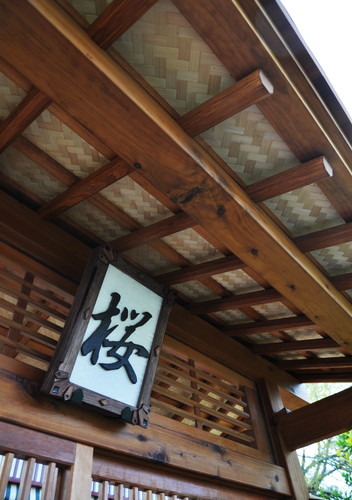

Sakura Lounge’s Guest House in Daylesford (Images provided by The de Keyzers)
— I believe the materials you can find here differ from Japanese ones. How do you overcome that?
Shaun: There are times we have to get materials from Japan because they just don’t have them here. When it comes to timbers, I think it makes most sense to use Australian grown ones as they will be more durable. Things turn out well as long as we use them right.
Neil: Just that, timbers we can get here in terms of size and type are way less than Japan. We can get something if we visit specialists. Still, they have around 2 -3 types to choose from. The sizes are fixed so if we want something bigger, we have to place special orders; if we want something smaller, we have to chop it at our workshop.
Shaun: Also, the timbers that can be used straight away are extremely rare because using them as they are somehow make the finishing products look shoddy. It’s said that hardwood timber is good while softwood timber is bad. The more I hear about this, the more I feel like using softwood. Whatever timber it is, it takes few decades before it is large enough to use. Isn’t that weird to assume this is good and that is bad just because of our false impression? This is why I am not so picky on the what types of wood to use.
Neil: Rather than types, things like, “The way of presenting and using it”, “Where to use it?”, “Are we giving our best?”, are more important. Just that, we are choosing one among 10, sometimes even 100 pieces of timbers, I guess the timber specialists aren’t very happy.
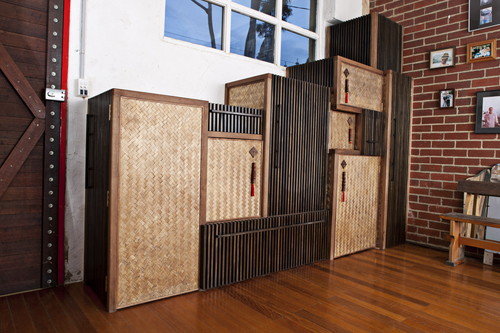
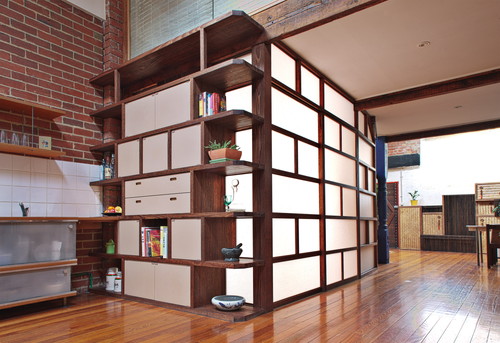
Special designs for a fashion designer’s home. (Images provided by The de Keyzers, taken by Roy Chu)
— To you, what is the difference between daiku and carpenter?
Shaun: To me, daiku and carpenter and handyman are all the same in terms of job classification. Whether or not you do your job with care and precision is what marks the difference.
— The two of you could build house too, couldn’t you?
Shaun: We can if requested.
— What are the things that you could not do even when requested?
Shaun: I don’t want to do what I am not able to do. Other than human limitation, like the work done by robots or machineries, I think anything a renowned craftsman can do, we can do it, too. We are open to all sorts of challenges.
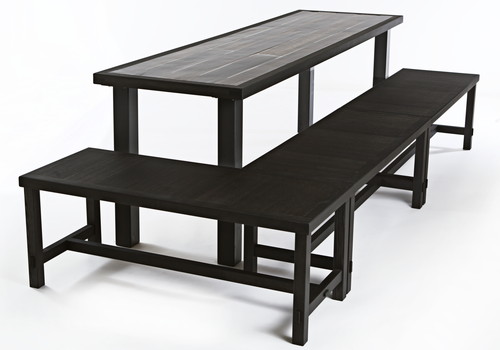
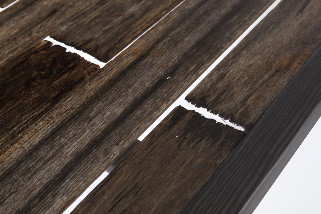
Tables and chairs custom-made for Wabi Sabi Salon (Images provided by The de Keyzers, taken by Roy Chu)
— Anything in particular you would like people to pay extra attention to regarding your profession?
Shaun: Rather than “to pay extra attention”, I hope they will look at our works and think, “hmm, there’s something different”.
Neil: I just want to make quality stuff. Growing up after the burst of the economic bubble in Japan made me think, “after all, what is the point of manufacturing so many different stuff in such large quantities?” I suppose Japanese are strucken deep these days. Like I think the sacrifices must be incredibly huge in return for being the world richest person. Frankly, we still don’t know what is considered “good” but in the mean time, we are just making what we are satisfied and happy with.
— By that, do you mean make each and every product wholeheartedly instead of mass production?
Shaun: It is said that Japanese get bored the quickest in the world because we keep creating something new at fast pace. But I’d say it’s because we didn’t really make something we truly love.
Neil: Most of us grown up in such environment, especially the Japanese. But then everyone is acutely aware of that fact ever since the earthquake in 2011. We too, have put in enormous effort into making something that can stand up to time. One thing even we can do here in Melbourne is to make something great enough to make you exclaim, “Wow, You Japanese Rock!” We will stick to this principle as long as we are in this business.
Shaun: I’d like to make timeless stuff that becomes interestingly tasteful every time you look at it. I think nothing can be more boring than something attracted you the most only at the point of purchase.
Neil: Even if the final product appears to be a little imperfect, it will turn out fine as time goes by if we have given our best. We are on our way to better designs, but we still stress on fundamental qualities like giving our best and being precise.


Works up for auction at the Charity Auction for The 2011 Tohoku Earthquake and Tsunami held in Wabi Sabi Garden
Maximum (left) Minimum (right)
(Photos provided by The de Keyzers, taken by Roy Chu)
— In other words, making something that reflects your qualities or something with a taste of “Japan” in Australia. Do you think you are in a sense, contributing to a new architectural movement?
Neil: I know making Japanese stuff as how they are in Japan, or finishing it with a touch of Japanese classics would make Australians happy. Just that, I want to be proud of what I do when it comes to “Japan”. Making stuff wholeheartedly is proud enough, but I want to take it to the next level.
— Working with siblings is tricky, I suppose. Have you ever had conflicts before?
Shaun: Neil (younger brother) gets irritated like during hay fever season.
Neil: Same goes for him. It’s getting better now but he has been so grumpy.
Shaun: He took it out on me! I was like, “hey don’t blame others.
Neil: And that’s what he did, too. I am not asking him to bettering himself by observing other’s behaviour, but I began to think these days, “you should stop doing that by looking at how I act”. I think he should thank me.
— Since the quarrel between the two of you have started, let’s just wrap up with this final question. What are the qualities that you acknowledge each other of?
Shaun: I don’t want to give compliments in front of him but it must be the most amazing imagination he has got there.
Neil: I’d say his incredible concentration at work. Just can’t beat that.

(Photos provided by The de Keyzers, taken by Roy Chu)
Photos: sHue 🙂



